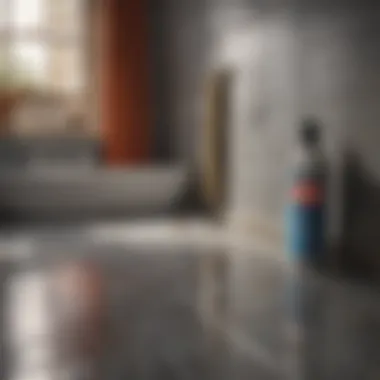Essential Techniques for Cleaning Bathroom Tile Grout


Intro
Bathroom tile grout can often be an overlooked aspect of home maintenance, yet it plays a significant role in the overall appearance and hygiene of your space. This section introduces the challenges faced when cleaning grout and highlights the importance of effective cleaning methods. Grout, subjected to moisture, soap scum, and mildew, demands regular attention to remain in good condition.
As homeowners, understanding the right approaches to grout cleaning can help maintain not just cleanliness but also enhance the longevity of tiled surfaces. In this article, we will explore various strategies, comparing chemical solutions with natural alternatives, ensuring that you are well-informed for a comprehensive cleaning regimen.
Cleaning Methods
Household cleaning can vary dramatically between those who prefer convenience and those who lean towards eco-friendly options. Here we address both perspectives.
Chemical Cleaners
Chemical cleaners have gained popularity due to their effectiveness in breaking down tough stains. Products featuring bleach or ammonia are often highlighted for their ability to sanitize and refresh grout lines. However, usage requires careful handling and proper ventilation.
- Pros: Often provide quick results and are widely available.
- Cons: Potentially harmful to the environment and require safety precautions during application.
Natural Solutions
Natural cleaning methods have garnered interest among homeowners looking for safer alternatives. Solutions like baking soda, vinegar, and hydrogen peroxide can be highly effective in tackling dirt and stains without harsh chemicals.
- Pros: Non-toxic, environmentally friendly, and usually cheaper.
- Cons: Results may not be as instantaneous as chemical cleaners.
Step-By-Step Cleaning
When it comes to cleaning grout, having a clear step-by-step approach can simplify the task significantly. Below, we outline a reliable method.
- Gather Supplies: Choose either a chemical cleaner or natural ingredients.
- Apply Product: Use a scrub brush or toothbrush to apply the cleaner to the grout lines.
- Let it Sit: Allow the solution to penetrate for a period, typically 10 minutes, to loosen grime.
- Scrub: Gently scrub the grout with your brush, using circular motions.
- Rinse: Thoroughly rinse with water to remove any cleaner residue.
- Dry: Dry the area with a towel to prevent mold growth.
Preventative Measures
Keeping grout clean is often about prevention as much as it is about cleanings. Here are some effective practices:
- Seal Your Grout: Regularly applying a grout sealer can prevent stains.
- Routine Maintenance: Establish a cleaning schedule, performing light cleaning weekly.
- Proper Ventilation: Ensure your bathroom remains dry to inhibit mold growth.
"Regular attention to your grout not only keeps your bathroom looking fresh but also extends the life of your tiles."
End
Understanding the methods and benefits of cleaning bathroom tile grout is essential for every homeowner. By giving equal consideration to chemical and natural cleaning options and implementing a thorough maintenance routine, grout cleanliness becomes manageable. This knowledge empowers you to keep your bathroom looking its best while prolonging the durability of your surfaces.
Understanding Bathroom Tile Grout
Grout is an essential component in the structure and appearance of bathroom tiles. It serves as a filler between tiles, creating a seal that prevents moisture penetration. This is especially important in humid environments like bathrooms. Understanding the nuances of bathroom tile grout goes beyond mere aesthetic considerations. An in-depth comprehension of its characteristics can help homeowners make informed decisions about maintenance and cleaning strategies.
One key aspect to note is the blend of materials that compose grout. It is typically made from cement, water, and sometimes additives that enhance its durability and stain resistance. The composition influences not only the appearance but also how easily it can become stained or damaged. Knowing what your grout is made of can inform the cleaning methods you choose, ensuring you do not cause unintentional damage.
In addition to its basic role in keeping tiles in place, grout can impact the longevity of your tile surfaces. Well-maintained grout preserves the integrity of the tiles and guards against mold and mildew growth. This protection is vital in maintaining a hygienic environment, particularly in bathrooms where moisture is prevalent.
Furthermore, understanding common issues related to grout can aid in diagnosing problems before they escalate, saving both time and expense in repairs. Issues like cracking, discoloration, or mold growth should prompt immediate attention to maintain a clean and safe bathroom space.
Grout's condition can affect not just the visual appeal of your bathroom, but also its overall hygiene and safety.


Overall, establishing a solid foundation of knowledge regarding bathroom tile grout is the first step toward effective cleaning strategies and routine maintenance.
The Importance of Cleaning Grout
Bathroom tile grout serves a dual purpose. It not only supports the tiles but also plays a crucial role in maintaining the overall appearance of the bathroom. Over time, grout can become discolored and stained, affecting the visual appeal of one of the most important spaces in the home.
Maintaining clean grout is significant for several reasons. First and foremost, it enhances the aesthetics of the space. Clean, well-maintained grout draws attention to the tiles and enhances their color and pattern. Conversely, dirty grout can make even the most beautiful tiles look unattractive.
Another important aspect to consider is the health implications associated with unclean grout. Grout can absorb moisture, creating a breeding ground for mold, mildew, and bacteria. These substances pose risks to health, particularly for individuals with respiratory issues or allergies. Regular cleaning can mitigate these risks, creating a safer environment for all.
Lastly, the longevity of tile surfaces is also dependent on the maintenance of grout. Grout that is not regularly cleaned and sealed can deteriorate quicker, leading to costly repairs or replacements. By prioritizing the cleaning of grout, homeowners can extend the life of their tiles and reduce the need for extensive renovation.
"Regular grout maintenance not only enhances the beauty of your bathroom but also protects your health and investment in tiles."
With these considerations in mind, it becomes clear that cleaning grout is not just an aesthetic choice but a wise measure for overall home maintenance.
Comparative Analysis of Cleaning Methods
The process of cleaning bathroom tile grout can be refined and enhanced by understanding the various methods available. A comparative analysis sheds light on the strengths and weaknesses of both chemical cleaners and natural solutions. This section emphasizes the importance of choosing the right approach based on specific needs and conditions. Homeowners can better navigate their options, selecting methods that align with their preferences for effectiveness, safety, and environmental impact.
Chemical Cleaners
Types of Chemical Cleaners
Chemical cleaners are popular due to their strong formulations designed to eliminate stubborn stains and grime. Products like bleach, hydrogen peroxide, and commercial grout cleaners contain potent active ingredients that can swiftly break down debris. The key characteristic of these cleaners lies in their efficiency, particularly on mold and mildew. They are widely regarded as a beneficial choice for tackling tough grout issues, making them favored among many households. However, it is essential to consider that these products often contain harsh substances which can be detrimental to both health and the environment. Their unique feature is the quick action they provide, which can translate into a significant time-saving factor for homeowners.
Advantages and Disadvantages
When discussing the advantages and disadvantages of chemical cleaners, the discussion centers on their effectiveness versus the potential health risks. One key characteristic is the powerful cleaning action that can restore grout to its original condition. This makes chemical products a popular option when speed and strong results are a priority. However, the disadvantages often include risks of skin irritation, respiratory issues, and environmental concerns related to disposal. Homeowners must weigh the efficacy of these cleaners against the potential harmful effects, allowing for a more informed decision about whether to integrate them into their cleaning routine.
Natural Solutions
Common Natural Ingredients
Natural solutions for cleaning grout rely on ingredients such as baking soda, vinegar, and lemon juice. These components are common household items that offer a safer alternative to chemical cleaners. The key characteristic of natural ingredients is their low toxicity, making them a favorable choice for households with children or pets. The unique feature of using natural solutions is not only their safety but also their effectiveness against light stains and dirt buildup. Many homeowners appreciate the peace of mind that comes from using substances that are safe for both the environment and their family's health.
Effectiveness and Safety
The effectiveness and safety of natural cleaning solutions contribute significantly to their appeal. While they may not compete with the potency of chemical cleaners for heavy stains, they provide a satisfactory cleaning experience for routine maintenance. The key characteristic of these solutions is their non-toxic nature, making them a popular choice for those who prioritize eco-friendliness. The unique feature is the dual benefit of cleaning and lessening chemical exposure in the home environment. However, some individuals might find that natural methods require more elbow grease or additional time to achieve the desired results when compared to harsher chemicals.
Using natural solutions might take longer, but it ensures a healthier home environment.
Understanding these comparative elements allows homeowners to make educated choices regarding grout cleaning methods, ultimately enhancing their cleaning routines.
Step-by-Step Guide to Cleaning Grout
Cleaning grout effectively is crucial for maintaining the overall appearance of a bathroom. Neglecting this task can lead to unsightly stains and bacteria buildup, making the space feel less inviting. This guide provides a structured approach to cleaning grout, allowing homeowners to follow clear steps that can result in significant improvement.
Preparation and Tools Needed
Before beginning the cleaning process, preparation is essential to ensure effective results. Gather the following tools:


- Stiff bristle brush
- Spray bottle
- Bucket
- Cleaning solutions (chemical or natural options)
- Old towels or rags
These tools will help in the thorough cleaning of the grout. Having everything on hand saves time and effort.
Applying Cleaning Solutions
Choosing the right cleaning solution is fundamental in the grout cleaning process. Depending on personal preference, one can opt for chemical cleaners or natural solutions.
Method for Chemical Cleaners
Chemical cleaners are popular due to their strength in removing tough stains. Common types include bleach-based cleaners and commercial tile cleaners. These solutions often break down residue effectively, allowing for a quick clean.
One notable characteristic of chemical cleaners is their efficiency. They can yield rapid results, especially in heavily soiled areas. Nevertheless, caution is necessary. These solutions can be harsh on the skin or respiratory system, so it is wise to use gloves and ensure proper ventilation during use.
Method for Natural Solutions
Natural solutions, such as vinegar and baking soda, are favored for their safer profiles. These ingredients can gently lift stains without the harsh effects linked to chemicals. Their effectiveness often lies in their ability to disinfect as well as clean.
While natural solutions may take longer to work compared to chemical options, they present a beneficial choice for those worried about health impacts. They are also more environmentally friendly, which resonates with many homeowners.
Scrubbing Techniques
Effective scrubbing improves the cleaning outcome significantly. It’s not just about the cleaning solution used, but also about how it is applied.
Best Tools for Scrubbing
For scrubbing, a stiff bristle brush is often recommended. Its durability allows for removed buildup without damaging the grout. A toothbrush can sometimes reach small crevices, ensuring no residue is left behind.
These tools are beneficial because they adapt well to different types of grout surfaces, providing versatility in cleaning routines.
Tips for Effective Scrubbing
Using a scrubbing method that includes circular motions can help to lift stubborn stains more effectively. Allowing the cleaning solution to sit for a short while before scrubbing further enhances its cleaning power.
It is essential to avoid excessive force as it might damage the grout lines; instead, a consistent, gentle motion will yield the best results.
Rinsing and Drying
After scrubbing, rinsing the area is critical to remove any remaining residue from the cleaning solution. This process ensures that dirt does not settle back into clean grout lines. Utilizing a clean bucket of water and old rags helps eliminate the remnants of cleaning products.
After rinsing, drying the surfaces is also crucial. Wiping down with dry towels helps to prevent water spots, which can be unattractive. Effective drying also reduces the risk of mildew growth in a bathroom environment.
By following these outlined steps, a homeowner can achieve cleaner, healthier grout that positively impacts the entire bathroom ambiance.
Preventative Maintenance for Grout
Preventative maintenance for grout is critical in ensuring the longevity and cleanliness of tiled surfaces. Grout can be prone to discoloration and damage over time due to water infiltration, mold growth, and general wear. Establishing a routine for maintenance not only keeps the grout looking fresh but also addresses potential issues before they escalate into larger problems. Thus, preventative measures save time and money in the long run.
Regular Cleaning Routines
Consistency is key when it comes to maintaining grout. Establishing a regular cleaning routine helps in minimizing buildup which can lead to stubborn stains. It is advisable to clean your grout weekly, using gentle cleaners suited for the material. During this routine, focus particularly on areas that receive heavy traffic or exposure to moisture, such as around showers and sinks. A simple solution of vinegar and water could suffice, or you could opt for store-bought products designed specifically for tile upkeep.


- Pick a day of the week that works best for cleaning.
- Use a soft-bristled brush to scrub the grout lines without damaging the tile.
- Rinse thoroughly with clean water to remove any residue from cleaning agents.
By adhering to a consistent schedule, you can significantly reduce the accumulation of grime and ensure that the grout stays in acceptable condition.
Sealing Grout
Sealing grout is one of the most effective steps in preventative maintenance. Grout is porous and can absorb liquids, leading to stains and mold growth. A high-quality grout sealer forms a barrier that prevents moisture from penetrating the surface. This practice not only prolongs the life of the grout but also makes future cleaning easier.
- Choose the right type of sealer: Look for a water-based or solvent-based sealer as per your need.
- Application frequency: Typically, sealing should be done every 6 to 12 months.
- Surface preparation: Ensure the grout is clean and dry before applying the sealer for the best adhesion and effectiveness.
Implementing sealing as part of your maintenance routine protects against harmful substances, keeping the tiled area safe and aesthetically pleasing.
Choosing the Right Products
The success of preventative maintenance relies heavily on the products one chooses. Selecting cleaners and sealers that are appropriate for your grout type is vital. Always opt for products specifically designed for cleaning and sealing grout, as general household cleaners might be too harsh and could damage the grout over time.
- Read reviews: Seek feedback from other homeowners about effective products.
- Research ingredients: Avoid cleaners with abrasive compounds that could scratch or wear down grout surfaces.
- Follow instructions: Adhere to the manufacturer's directions to maximize effectiveness and safety.
When to Seek Professional Help
Recognizing when to enlist the expertise of a professional for grout cleaning is crucial for maintaining the integrity of your bathroom tiles. While many homeowners can manage routine cleaning and minor maintenance, certain scenarios necessitate professional intervention. These situations often arise when the damage to the grout is extensive or when typical cleaning methods fail to yield satisfactory results.
Signs of Extensive Damage
Damage to grout can manifest in various forms. One of the primary indicators that professional help is required is the presence of cracking or crumbling grout. When grout starts to break apart, it compromises its effectiveness, allowing moisture to penetrate. This can lead to mold and mildew growth, which can be detrimental to your health and cause additional damage to your tile.
Furthermore, discoloration beyond surface stains can signify deeper issues. If the grout appears stained or darkened, and regular cleaning efforts do not improve its appearance, it is advisable to consult a professional. Their expertise can help identify the underlying causes and provide solutions that are not only effective but also safe for your tile and health.
In addition to visible damage, if your grout emits an unpleasant odor, it may suggest a serious problem. Mold and bacteria thrive in damp conditions, and without proper intervention, they can contribute to health issues in your living environment.
Cost-Benefit Analysis
When considering whether to call a professional, a cost-benefit analysis can guide your decision. Hiring a professional cleaner typically incurs costs that vary based on the extent of work needed and local market rates. However, the potential benefits often outweigh the expenses.
Investing in professional cleaning can restore your grout to its original condition, extending the lifespan of your tiles and preventing costly repairs or replacements down the line. Additionally, professionals have access to superior cleaning products and techniques that can achieve results that DIY methods may not.
Moreover, the time and effort required to perform extensive cleaning yourself may not be worth it if the task exceeds your capabilities. Balancing the cost of professional services against the value of your time and the outcome is crucial. In many cases, resolving grout issues efficiently through professional help leads to overall savings—not only in costs but in terms of maintaining a healthy and appealing bathroom environment.
"Recognizing when to seek professional help can save you time, effort, and potentially high repair costs later."
The End and Final Recommendations
Cleaning bathroom tile grout should be an integral part of your home maintenance routine. The significance of keeping grout clean extends beyond aesthetic concerns. Dirty grout not only detracts from the overall look of your bathroom but can also harbor germs and mold, which pose health risks. Effective cleaning strategies can help maintain the appearance and integrity of tile surfaces over the long haul.
Summarizing Effective Techniques
In this article, we discussed various methods for cleaning grout effectively. Here are the key techniques:
- Chemical Cleaners: These cleaners offer robust solutions for tough stains and discoloration. Their effectiveness is often quicker than natural alternatives, but one must take precautions to avoid any adverse health effects from harsh chemicals.
- Natural Solutions: Baking soda, vinegar, and hydrogen peroxide serve as excellent alternatives for those who prefer non-toxic methods. These solutions are less caustic and can be equally effective when used consistently.
- Step-by-Step Process: Understanding the preparation, application, scrubbing, rinsing, and drying process is crucial to achieving lasting results. Each step plays a vital role in maximizing cleaning efficacy.
Utilizing these techniques not only enhances your bathroom’s look but also extends the life of your tiles. Regular use of these cleaning methods will keep grime at bay, ensuring surfaces remain sanitized.
Encouraging Consistent Upkeep
To maintain the cleanliness of your grout, consistent upkeep is essential. Setting a regular cleaning schedule is one of the best ways to prevent build-up. This may involve a simple weekly wipe-down with natural solutions or a more thorough clean monthly.
- Emphasize on Sealing Grout: After initial cleaning, it is advisable to seal your grout lines to protect against future stains. This protective layer can make routine cleaning significantly more manageable.
- Choosing the Right Products: Selecting appropriate cleaning products tailored for your grout type will further enhance cleaning outcomes. Always read labels and ensure compatibility with your existing tile materials.
Ultimately, keeping your bathroom tile grout clean may require some effort and diligence. However, the benefits are tangible, offering a cleaner environment and a more visually appealing bathroom.















